Waterproofing the floor in the apartment: features of the choice of insulation materials + work procedure
In the water supply and heating systems, breakdowns often occur, therefore there is always a risk of water leakage. Agree, this can cause a lot of trouble, such as, for example, the flooding of someone else’s apartment or the destruction of their own floor coverings. Also, do not forget that excessive moisture can lead to mold and mildew, which will negatively affect health.
Therefore, it is necessary to take care of moisture protection in advance, namely: at the very beginning of the repair. To do this, waterproof the floor, which will serve as a reliable barrier against water.
Next, we will tell you how to independently perform waterproofing work in the apartment, and also help with the selection of suitable materials.
The content of the article:
The main advantages of floor waterproofing
Waterproofing is a protection of the concrete base, screed and front floor covering. Experts advise to carry out hydraulic protection immediately before the screed, since concrete is able to absorb moisture through micropores, and subsequently collapse.
This is especially true for owners of apartments on the ground floors, since the screed is influenced by cold (from the basement) and warm (from the apartment) air flows.
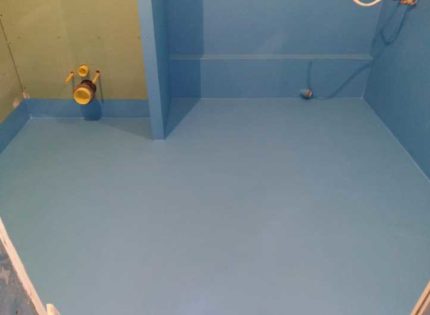
However, the most reasonable option would be to perform floor waterproofing throughout the apartment, because:
- in the solution that is used to screed the floor there is water, so there is a risk of leakage to neighboring apartments located below;
- the heating system may fail, which will also lead to flooding of the lower floors;
- waterproofing will increase the strength and durability of the floor, protect against the appearance of microcracks;
- when installing a warm floor system, waterproofing is required.
It should be noted that it is especially necessary to equip waterproofing in areas located in the vicinity of plumbing equipment.
Selection of insulation materials
A wide range of waterproofing for floor coverings is presented on the building materials market, which differ depending on the application method and area of use.
Let us further consider in more detail the main types of waterproofing materials.
Rolled waterproofing materials
The basis of roll waterproofing is fiberglass or a mixture of polyester resins.
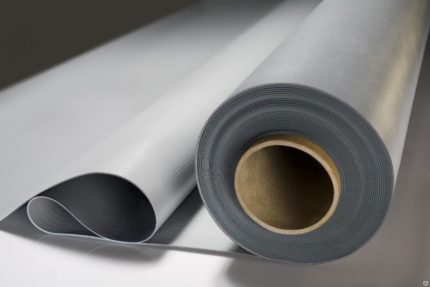
Such coatings include hydroisol, isoplast, ruberoid and the like.
Depending on the mounting method, there are such types of roll insulation:
- Glue. Fastens with bituminous mastic or glue based on synthetic resin. There are also self-adhesive options. The base must be well prepared. It is considered a simple option, as it does not require special skills.
- Surfaced. The basis is polyester or fiberglass. Using a gas burner or a hair dryer, the lower layer of insulation (bitumen) is melted and then installed. This method is undesirable to use indoors, since bitumen vapors are toxic.
- Mechanically mounted. The basis for this species is sand with a fine fraction or roofing material. It is fixed with self-tapping screws. The option is time-consuming and not reliable enough.
The main reason for choosing roll waterproofing materials is their relatively low cost. Another advantage of roll coatings is the ability to immediately carry out further repairs.
The disadvantages include the difficulty of installation in a small area, for example, In bathroom.
It is also worth noting that during the installation of rolled waterproofing, seams are formed, which in the future can violate the tightness of the protective coating.
Lubricants for waterproofing
Today, coating materials are the most popular materials for waterproofing, and even roll materials are supplanted in their effectiveness.
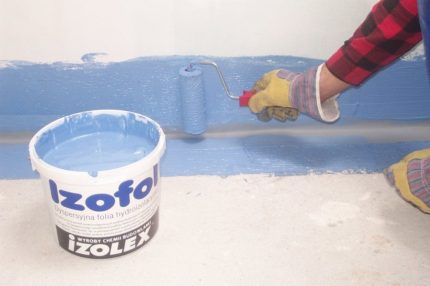
After applying the mastic, a film is formed, which will serve as a protective barrier against exposure to unwanted moisture. Mastic materials for floor waterproofing are based on bitumen, acrylic and synthetic resins.
Depending on the constituent components and operational characteristics, there are several varieties of coating materials:
- Cement Mastics. They include cement, fine quartz sand and polymer additives. The material has high adhesion and durability. The disadvantage is the drying time of the finished surface.
- Bitumen. Depending on the application method, mastics of hot and cold application are isolated. The latter option is better suited for waterproofing the floor in an apartment, since bitumen does not require heating to 160-180 ° C, in contrast to mastic of hot application.
- Polymer bitumen. Basically, compositions are made based on the modification of bitumen with latex, polyurethane or acrylic. The materials have great strength along with high adhesion. They have a higher cost than previous types of mastics.
- Acrylic. Compared with bitumen materials, it is much more environmentally friendly and odorless. Suitable for underfloor heating systems. Their main disadvantage is the high cost.
Ready mastics and dry mixes are on the market. It is enough to dilute the latter with water according to the instructions from the manufacturer.
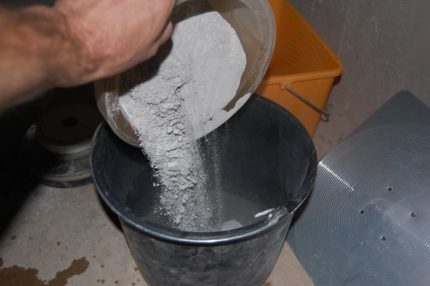
When choosing a suitable mastic, it is necessary to take into account not only the price of the material, but also the indicated consumption per 1 m2. Often, inexpensive mastics are more viscous, which increases the manufacturer's claimed material consumption.
Penetrating Compounds
The effect of penetrating mixtures, the so-called "impregnation", is based on penetration into the structure of the concrete base and the ability to react with it.
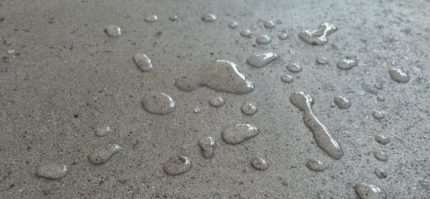
Before applying the impregnation, the concrete surface must be moistened. In addition, prior to the use of impregnation, the preliminary use of a primer is not required, which will significantly reduce the cost of materials.
It should be noted that impregnation is not applied on the surfaces of foam concrete, aerated concrete and brick, since the necessary chemical reaction will not occur. The main disadvantage of the application is the high cost of materials.
The procedure for waterproofing
Almost all waterproofing methods include preparing the base, priming the surface and installing waterproofing materials. Consider the features of possible techniques in more detail.
Methods of roll waterproofing the floor
First of all, it is necessary to prepare the surface, namely: to dismantle the old coating to the concrete base, as well as to clean the floor from dust and debris.
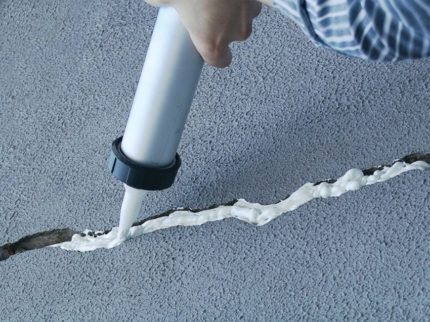
When installing waterproofing in the bathroom and toilet, you will need to remove all plumbing equipment.
Of all the presented types of roll insulation for an apartment, it is advisable to choose an adhesive type of waterproofing.
After cleaning, the floor must be primed. The material is cut to the size of the room, leaving an overlap for lapping on the walls - approximately 10 cm. Cut strips must be left on the floor for a day so that it is leveled.
The area of the room around the perimeter is glued with a special construction tape or waterproofing tape. The material is glued with glue or mastic on a polymer-bitumen basis. The prepared strips overlap each other with an overlap of at least 15 cm, while the joints of the strips are additionally glued with mastic.
There are also self-adhesive materials, the installation of which is easier, since the application of glue on the floor base is not required. You can mount roll waterproofing using a roller or pinch roller.
Experts advise making such waterproofing in two layers, one layer perpendicular to the other, after drying the previous one.
Installation of coating waterproofing
Coating waterproofing is considered the simplest method of insulation.
As in the previous method, in the beginning the preparation of the base is carried out. If a dry mixture is chosen for work, then you need to prepare the solution according to the instructions on the packaging.
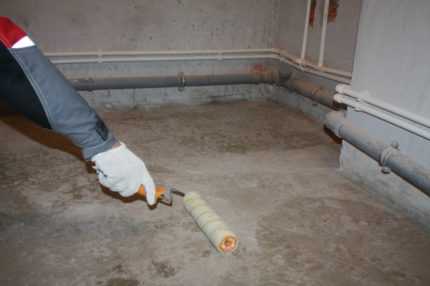
Mastic is convenient to apply with a roller, after pouring it into the tray. All corners are worked out with a brush.
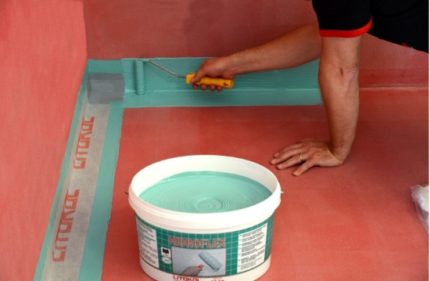
The waterproofing material is applied in two layers. Interlayer drying between the first and second application is 2-4 hours.Repair work can be continued after the mastic has completely dried, after about 10-15 hours.
Penetrating waterproofing technique
This method is considered the most effective, since it can withstand the results of even a serious pipeline breakthrough. Penetrating waterproofing also prevents corrosion of the reinforcement.
The execution technique is similar to the previous method.
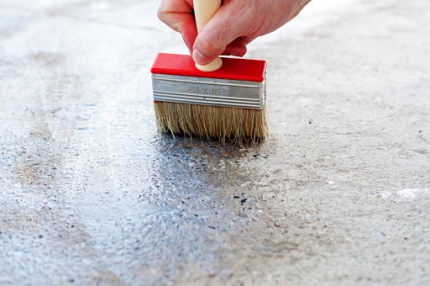
The drying time of the solution usually does not exceed one and a half hours, after which you can begin to fill the screed.
Conclusions and useful video on the topic
The method of waterproofing the floor using self-adhesive roll waterproofing:
Technology for coating waterproofing of the floor:
Waterproofing the floor can be done independently, however, the use of any material for waterproofing the floor has a number of its own characteristics and you must strictly adhere to the manufacturer's instructions.
During the repair, be sure to take care of water protection, which will protect your apartment from the negative effects of water. And, by the way, it will help to save finances, because the cost of water protection is relatively small compared to repairing floor coverings or an apartment to neighbors in case of flooding.
And what kind of material for waterproofing the floor in your own apartment did you choose and why did you choose it? Tell other visitors to our site about this.

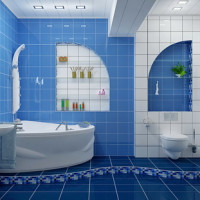 Do-it-yourself waterproofing in the bathroom: a comparative overview of materials + installation instruction
Do-it-yourself waterproofing in the bathroom: a comparative overview of materials + installation instruction 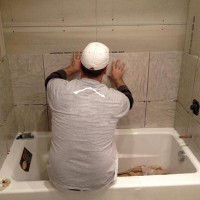 Waterproofing a bathroom under a tile: what is better to use under a tile
Waterproofing a bathroom under a tile: what is better to use under a tile 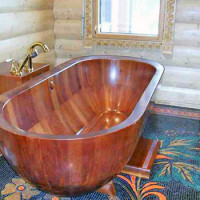 Bathroom in a wooden house: the rules of arrangement and features of decoration
Bathroom in a wooden house: the rules of arrangement and features of decoration 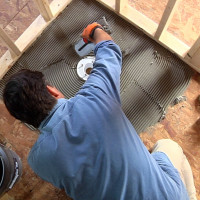 DIY shower cabin: the order of construction and connection to communications
DIY shower cabin: the order of construction and connection to communications 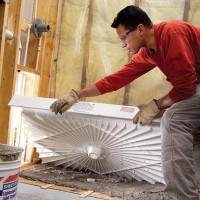 How to assemble a shower tray: mounting options for typical options
How to assemble a shower tray: mounting options for typical options 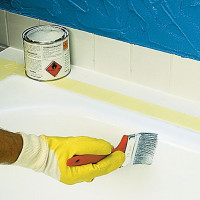 How to update an old cast-iron bath: a review of restoration and repair work
How to update an old cast-iron bath: a review of restoration and repair work  How much does it cost to connect gas to a private house: the price of organizing gas supply
How much does it cost to connect gas to a private house: the price of organizing gas supply  The best washing machines with dryer: model rating and customer tips
The best washing machines with dryer: model rating and customer tips  What is the color temperature of light and the nuances of choosing the temperature of the lamps to suit your needs
What is the color temperature of light and the nuances of choosing the temperature of the lamps to suit your needs  Replacement of a geyser in an apartment: replacement paperwork + basic norms and requirements
Replacement of a geyser in an apartment: replacement paperwork + basic norms and requirements